

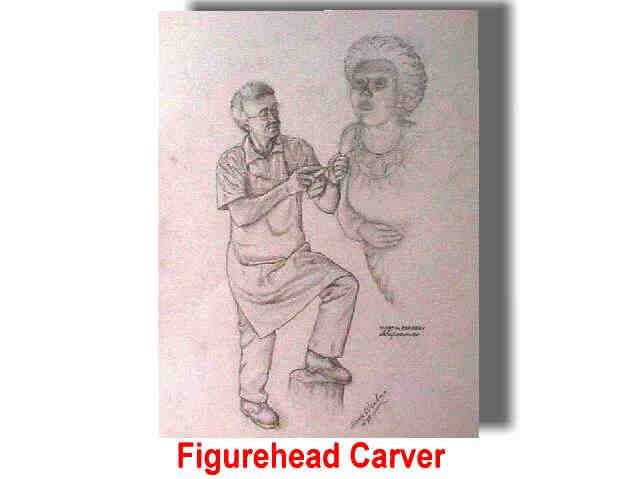

(Now in ONE page please wait for pics to load).
Of all the objects made by man, the ship almost achieves a life of its own. When considering a figurehead, therefore, it is important to remember the ship that bore her. The ships have gone, but these wooden angels remain to tell their tales to those who care to listen.
The figurehead, first and foremost, how do you carve a figurehead? There is no mention about this technique in any of the reference libraries...well....
The carver's shop of old was located in a discarded sail or mold loft, often upstairs, so that he could rub elbows constantly with shipbuilding folk keeping abreast of activities on the wharf. He lived among those who went to sea and those who built and equipped vessels. The window of the workshop usually looked out over the water.
He watched ships and cargoes from distant lands tie up at the wharves. It was likely that he saw ships returning with his own figureheads at their prows.
The workplace of the shipcarver today (rare), is for all the world like a very messy old curiosity shop. Wood tools hang about the walls, on benches and scattered about on the floor on a bed of wood chips and saw dust. The tools are a mixture of old and new. Some carving tools are at least 100years old and still in fine condition (Herring Bros), although the steel is a little brittle.
In one corner there is a thicknesser or power planer, a hand power planer, a band saw in another corner and various saws, power and hand, scattered about. An assortment of dusk masks and eye goggles are always at arms length. Containers of resins and powdered hardeners are tucked away under the main bench in an assortment of coloured pots.
The initial steps before carving the figurehead is first to consider the shape of the ship's bow, the rake of the bowsprit and the vessel's length. These proportions depend on the size of the figure. For example, a ship of 450 feet would have a figurehead, outside the stemhead, of 9 feet 6 inches, while a vessel of 100 feet would have a figurehead outside the stemhead of 6 feet. We must also keep in mind the Trail Boards, the scrolls patterns that run either side of the figurehead and should blend in sweetly, however more on that later.
Calculations also have to be made of the depth and breadth of the figurehead, so that its breast and sides will not be in the way of heavy martingale backstays and bobstay chains that lead to the dolphin striker that is on the bowsprit. One of the major hurdles is to have the finished figurehead fit smoothly under the bowsprit, sliding into position, a major calculation, which nearly always leads to a few carving modifications with the ship carver on hand.
![]() These two figureheads were recently carved and shipped to the USA.
These two figureheads were recently carved and shipped to the USA.
Click on the picture to see an overview of their carving process.
The next consideration is the wood to be used for the carving. Timber in the old days was generally the hardwoods of elm and oak with good properties to withstand the exposure and the buffeting from heavy seas. Today, yellow pine is generally used for carvings of this nature. A excellent carving wood and quite stable. The Warrior figurehead, a massive piece, began with a three ton lamination of yellow pine and when finished, produced a two ton sculpture, which incidentally was finished in the late spring on 1983 and now is in Portsmouth England.
A magnificent piece of carving, by two great figurehead carvers,Jack Whitehead (a farewell tribute) and Norman Gaches, among the last professionals in their trade in the world.
If these woods are not available, a search for durable timbers that will be stable in all weathers and not under attack from various infestations. Almost unavoidable. Choose woods like Island Beech, Miva Mahogany, Brazilian Mahogany, Calantas, Huon Pine, Elm etc. It would be a good idea to choose a non-endangered species if possible like Camphor Laurel, a weed in Australia( a good carving wood, if you can stand the strong smell when carving).
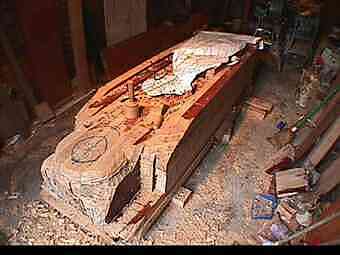
The above photograph is a laminated
block of Island Beech, to be carved into a figurehead of a woman for the 179
foot, three masted iron barque, the James Craig, owned by the Sydney
Heritage Fleet.
The planks of Beech were cut into 6 foot lengths from
plank sizes ranging from 11 feet to 14 feet. The width varied with this stack
from 6inches, 8inches to 11 inches. The thickness varied in each plank quite
considerably from 2 1/2 inches to 3 1/4 inches and I had a considerable amount
of work planing the surfaces through a thicknesser for an exact fit ready for
gluing. I would of had this done at the supplier, but his machinery was down.
The wood was then laid out and care taken to arrange
the planks in such a fashion, that the end grain was not in critical carving
places like the face and hands. End grain is very difficult to carve. The grain
of the wood was arranged in the same direction for carving her drapery.
I used Resorcinol Resin for this lamination. This resin
is used for marine work and when fully cured is resistant to chemicals, salt
water UV etc. The bonding strength is massive. It is in two parts, resin and
hardener. 5 Parts of Resin to 1 part of Hardener by weight. I clamped the block
well with many types of different clamps, and some I invented myself especially
for the job and waited a good 12 hours before the first blade made an
impression.
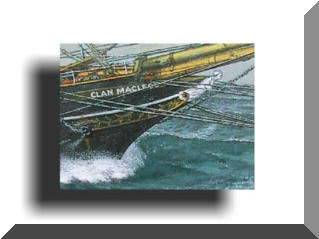
Initially, the laminated block is on the ground, and I will begin carving the top of the head, the shoulders and back and the top of the drapery. When this has been roughly shaped, I will hoist the block to the correct rake of the ship's bow.
This angle has to be exact in order to 'get the feel' of carving the correct posture for the figurehead.
The shape of the figure slowly comes 'alive' when carved in this position, as though she were actually attached to the ship. You can begin to visualize the end result. This is important for the correct proportions.
Figurehead Taking Shape
The 12mm thick stainless steel plates embedded in the centre bottom and another under the scroll head of the figure was positioned so when lifted it will balance without being front heavy. Two are required when eventually fitted to the ship and bolted into the final position.
The figurehead is now beginning to take shape, with definite cuts made into the body. Measurements are always being taken and reference lines drawn on the figurehead so as not to over cut and also to keep correct proportions. I always stop momentarily and step back to view the sculpture from various angles, so as to get the 'feel' that its going right.
Figurehead Carving cont'd............
The famous Bostonian clipper shipbuilder, Donald Mackay in the 1800s decorated his ships with elegant figureheads. He was a very successful builder and one author described in his passage, 'The Building of a Ship'...
'And at the bows and image stood, By a cunning artist carved in wood, With robes of white that far behind Seemed to be fluttering in the wind. It was not shaped in a Classic mould, Not like a Nymph or Goddess of old, Nor Naiad rising from the water, But modelled from the Master's daughter! On many a dreary and misty night, 'Twill be seen by the rays of the signal light Speeding along through the rain and the dark, Like a ghost in its snow-white sark, The pilot of some phantom bark, Guiding the vessel, in its flight, By a path none other knows aright!.....
I have roughly carved the front and now working my way to the rear. This is a good way to get correct proportions. The scroll heads will be carved at the correct angle of the bow, so as to fit flush against the hull of the ship.
The start of the trail boards will also be carved within the scroll head. I will show more of this soon......
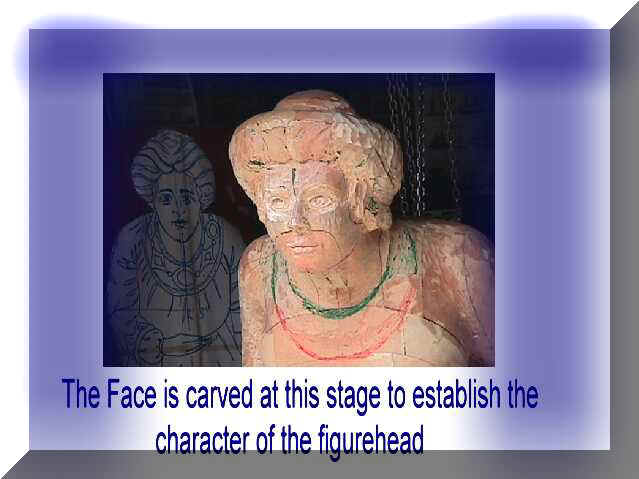
It is important to carve the face at this stage so as to establish the figurehead's character. It's a good idea to spend some time getting the face just "right". This sets the tone for the remainder of the carving process. First thing in the morning, I take a good look at the face, which prepares me for the day's carving. This may sound a little strange, but has the effect of setting a particular style for the carving of the drapery, hands etc.
Detail Carving
The right hand and neck are carved at this stage. The Figurehead is raised to almost 90 degrees to carve the hand. The neck and hand require a lot more detail and the figurehead will remain in this position until they are finished. The left hand (which I'll show soon), will be holding the drapery and this is a good position to carve it in. It is very important to study the hands. It is easy to make the grave mistake of carving a masculine pair, so it's good to examine carefully how feminine and masculine hands differ. Easy, you may say, but to actually carve them properly requires careful examination and application. The hands tell a lot about the character of the person or in this case, the carving. If the face is studied with solid attention, then it should dictate the form and character of the hands.
The left hand is now carved (more detailed work towards the figureheads final stages), holding the drapery. It is important to carve the hand lightly clutching the drapery, gripping it 'not' like a judo hold. The hand should be graceful and elegant and show good detail when finished. *When the ship is at sea and at some distance, the fine detail of course cannot be observed. However, when the ship is at berth, the figurehead is always carefully scrutinized from ‘all’ sides, so it’s most important that the detail is correct and easily perceived. I will show all parts of the figurehead with the finished details – hands drapery – face – scroll heads – etc. In the next few days I’ll be starting on the scroll heads and give a complete account of the process.
Now is the time to carve the left scroll head. It is only roughly cut at this stage so it can be modified and altered to match the right hand side scroll head. The important thing when carving this particular area of the figurehead, is that it has to follow the angle of the bow, around 70 degrees in this case. Detail work always comes when the cut is right on a particular section of a figurehead and you can see that a satisfied "balance" is accomplished. The Scroll pattern will trail off the end of the head.
The Scroll Head is now carved, making sure that the middle of the scroll "Head" is cut to the same angle as the ship's bow and the scroll itself, carved at the angle of the bow to meet the start of the trail board/s. The wood below the immediate scroll will be cut, also to the ship's rake. This wood only remains to support the base of the figurehead at this stage and I'll show the final shape soon!
The Figurehead is now turned on its back in order to carve the drapery. The Scroll Heads will be carved in this position also. In this position, which is like viewing the figurehead from below when it's attached to the ship's bow, gives a good perspective for the sweep of the drapery and the correct angle for carving the start of the scroll patterns that attach to the Trail Boards.
This is the shape of the base of the Scroll-Head. The two supports have been cut off and the figurehead is now supported by a bolted plank for stability. I've cut the drapery grooves fairly deep so it can be seen to be flowing. This is important, especially from a distance. The top ends of the drapery will now be carved so as to flow into the scroll heads on both sides. This will be shown in a day or so.
I'm now well into the carving of the Scroll-Head. The left side is now taking shape. I've also carved the drapery flowing around the back of the head. This is in keeping with the particular style of this ship's original figurehead. The center of the scroll head ("wheel"), is carved at an angle to the ship's bow. In this case about 70 degrees. As it unwinds from the center, the angle is slightly increased. More soon...........
I've filled in the back now with timber and machined the interior of both rear drapery sides to an angle of 70 degrees. This is the angle of the bow where the figurehead will be anchored. At no time will these sides touch the vessel's hull, having an approximate clearance of 2 inches, either side.
I've given the figurehead a liberal coating of wood preserver resin turning the wood a pinkish color. Just a natural reaction. This has to be liberally applied, particularly on marine carvings of this nature to ward off tropical infestations, white ants, wood borer and makes the wood waterproof. It also cuts down UV and protects from rot. I've also driven in heavy oak dowels into the body at key places. This reinforces sections of the figurehead that are not quite as strong as others, e.g. arms, head, scroll head wheel etc.
The Figurehead is finally bolted under the bowsprit. White lead has been used to seal the back of the figurehead, so water will not run down her back, that could rot the timbers over the years. I've had to work on her at the bow, making a few modifications to get a tight fit and remove tar and scuff marks and re-paint and sand some detailed work that was slightly damaged during the fitting process - inevitable.
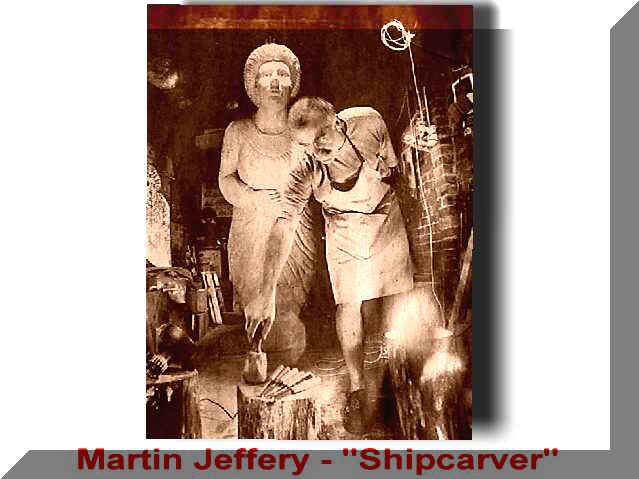
Please visit my other maritime carving site.
Take a look at the carving process
Ship's Figurehead Carving Message Board
Click on the picture to take you to the Pirate Shipwreck...For Sale!!
I hope you've enjoyed this small voyage into figurehead carving. Please send comments or questions, or if you have a specific question on figurehead carving, ship carving in general, tall ships or on the golden age of sail... I'll be happy to try and answer them.(click on the text or windjammer pic to send). Thanks.